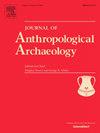Mask motifs in the land of geometrics. A systematic exploration of the rock art landscapes of Southern Mendoza region (Central-West Argentina)
IF 2.2
1区 社会学
Q1 ANTHROPOLOGY
引用次数: 0
Abstract
This paper is based on a theoretical perspective focused on the materiality of rock art: breaking away from the primacy of communication and representation in the archaeology of art, it proposes a set of concepts to approach the engagement of people with rock art via its techno-visual and performative qualities. These concepts are applied to a regional case study in Southern Mendoza (Central-West Argentina), in order to characterise the visual codes underlying the materiality of images. Rock art landscapes are characterised by analysing a database of 89 sites in the three biogeographical units: Altoandina, Patagonia and Monte. Technical choices are related to taphonomic and economic factors such as differential conservation of engravings vs. paintings, support hardness, and labour investment in image production. A relational map shows two different sets of inter-site relations, each one characterised by recurring motif-class combinations within the region. The links between motifs’ morphologies and techniques are systematically analysed, leading to the identification of certain motif classes (e.g. geometric motifs) which were “technically-flexible” enough to be produced via different techniques –their meanings being probably more rooted in their morphology–, versus other “not technically-flexible” motif classes (e.g. head-mask figures) which were only produced with specific techniques, thus suggesting that their contents/messages, aesthetic effects and performative functions stemmed from a combination of techno-visual and morphological features embedded in their materialities. In sum, the paper shows how the engagement of people with rock art motifs and landscapes involves perception and production processes that shape their materialities.
几何领域的面具图案。对南门多萨地区(阿根廷中西部)岩石艺术景观的系统探索
本文基于一个关注岩石艺术物质性的理论视角:脱离了艺术考古学中交流和表现的首要地位,它提出了一套概念,通过岩石艺术的技术视觉和表演品质来接近人们与岩石艺术的接触。这些概念被应用到南门多萨(阿根廷中西部)的一个区域案例研究中,以描述图像重要性背后的视觉代码。岩石艺术景观通过分析三个生物地理单元(Altoandina, Patagonia和Monte)的89个地点的数据库来表征。技术选择与地貌学和经济因素有关,例如雕刻与绘画的差异保护,支撑硬度和图像制作中的劳动力投资。关系图显示了两组不同的站点间关系,每一组都以区域内重复出现的主题类别组合为特征。系统地分析了图案形态和技术之间的联系,从而确定了某些图案类别(例如几何图案),它们具有足够的“技术灵活性”,可以通过不同的技术制作-它们的意义可能更植根于它们的形态-与其他“不具有技术灵活性”的图案类别(例如头罩人物)相比,它们只能通过特定的技术制作,因此表明它们的内容/信息,美学效果和表演功能源于其材料中嵌入的技术视觉和形态特征的结合。总之,本文展示了人们与岩石艺术主题和景观的接触如何涉及塑造其材料的感知和生产过程。
本文章由计算机程序翻译,如有差异,请以英文原文为准。
求助全文
约1分钟内获得全文
求助全文
来源期刊

Journal of Anthropological Archaeology
Multiple-
CiteScore
4.00
自引率
11.10%
发文量
64
期刊介绍:
An innovative, international publication, the Journal of Anthropological Archaeology is devoted to the development of theory and, in a broad sense, methodology for the systematic and rigorous understanding of the organization, operation, and evolution of human societies. The discipline served by the journal is characterized by its goals and approach, not by geographical or temporal bounds. The data utilized or treated range from the earliest archaeological evidence for the emergence of human culture to historically documented societies and the contemporary observations of the ethnographer, ethnoarchaeologist, sociologist, or geographer. These subjects appear in the journal as examples of cultural organization, operation, and evolution, not as specific historical phenomena.
 求助内容:
求助内容: 应助结果提醒方式:
应助结果提醒方式:


